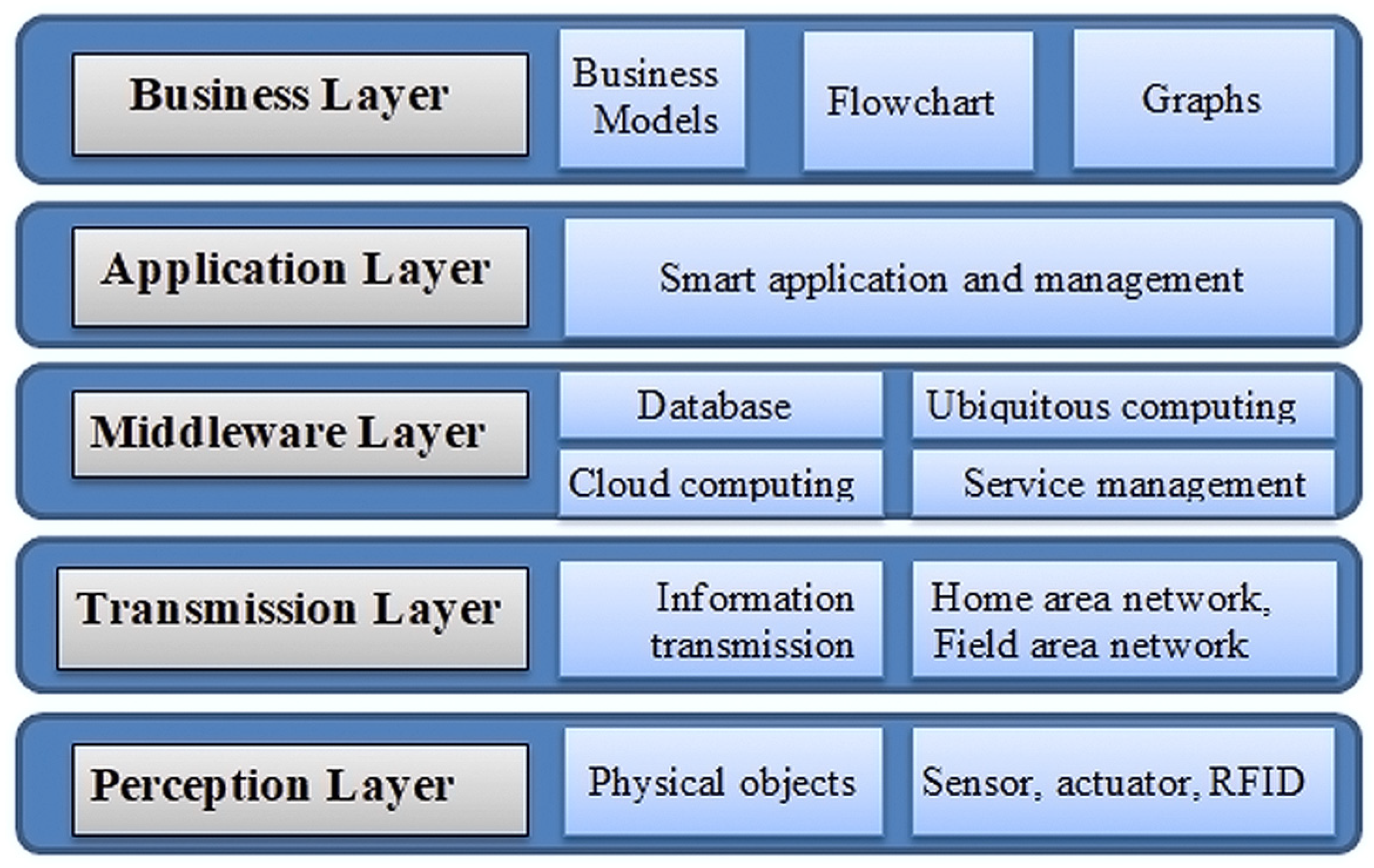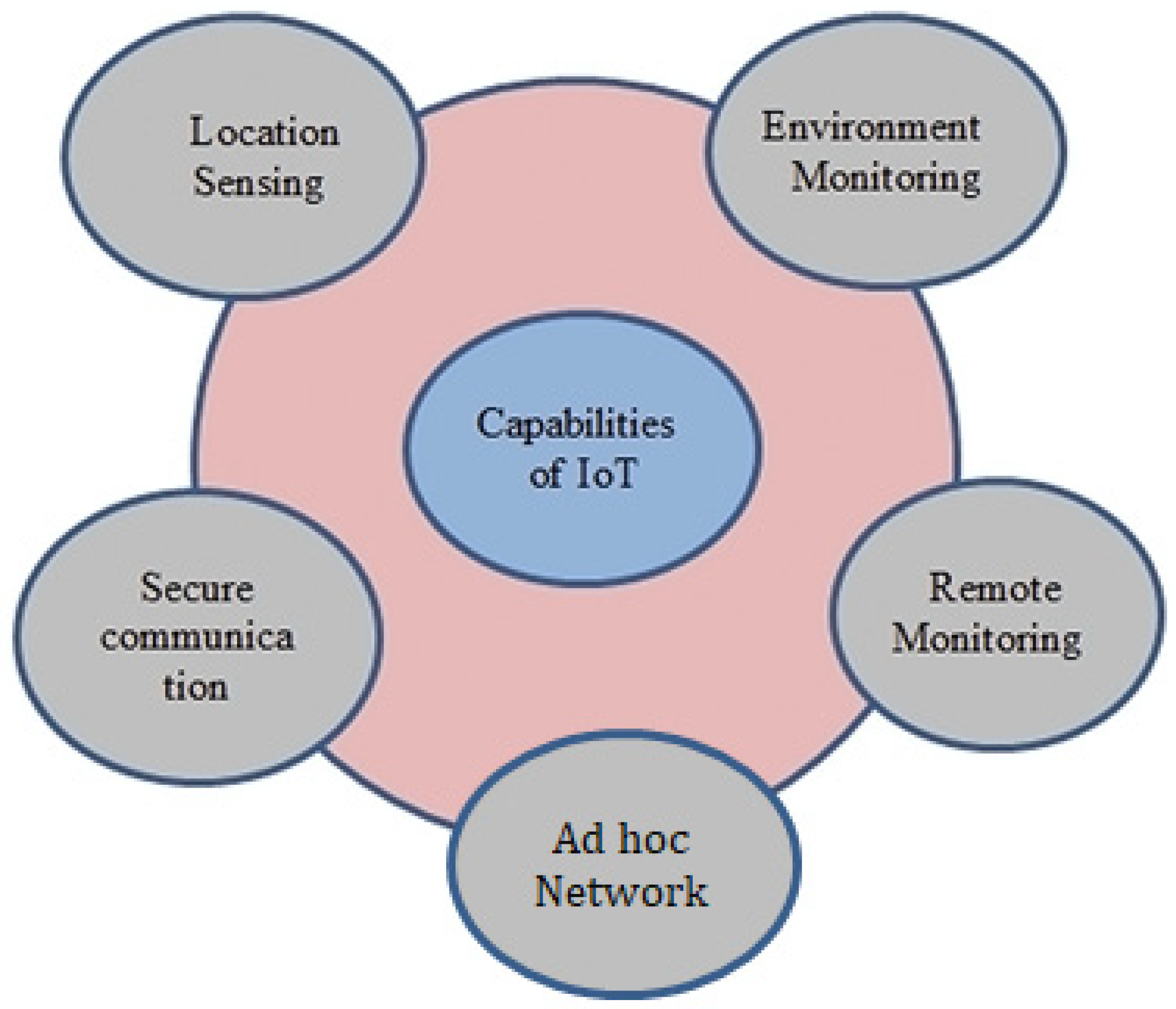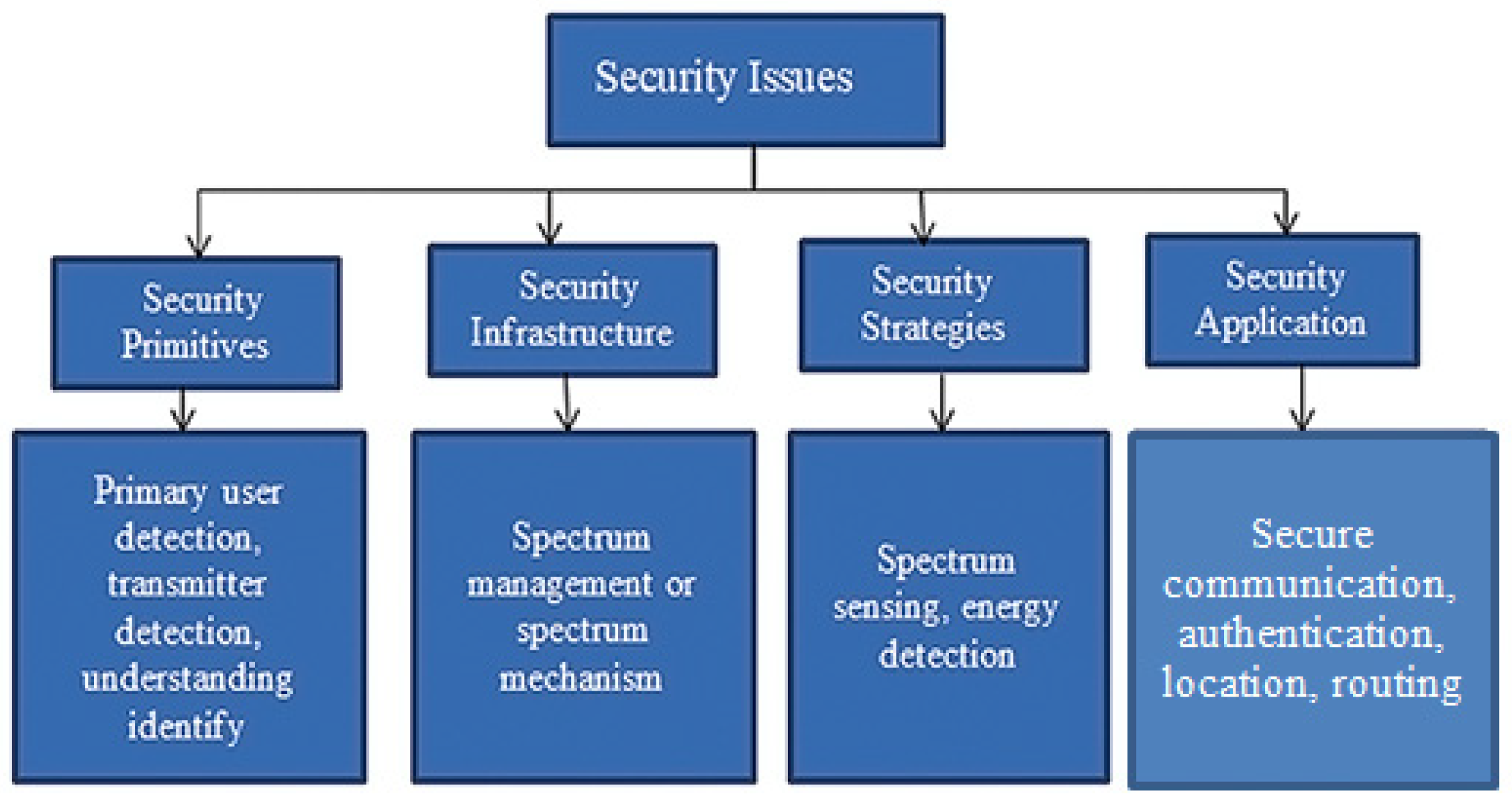Cognitive Radio Network Technology for IoT-Enabled Devices †
Abstract
1. Introduction
- Implementing a strategy for opportunistic spectrum access, commonly known as DSA.
- Spectrum sharing, which refers to the process of allowing primary user (PU) and secondary user (SU) systems to share the spectrum that is currently available.
2. Spectrum Sensing Strategy
2.1. Spectrum Sensing Technique
- H0: The status of the channel is idle, which means it is available for opportunistic usage secondary users (SUs) and means no licensed user signal is present (PU):
- H1: The status of channel is busy, meaning a licensed user (PU) signal is active, leading to preventing SUs from occupying the spectrum:
2.2. Machine Learning with Spectrum Sensing
- Learning without supervision is an option that could be practically viable for cognitive radio networks that operate in unknown RF environments.
- In the case that cognitive radio already possesses previous data regarding the surroundings, it may make use of this information by employing the supervised learning technique.
3. Cognitive Radio Network Based on IoT
3.1. Internet of Things Definition
- The radio frequency identification (RFID) tags, sensors, actuators, etc., that make up the physical world are represented by the Perception (or Recognition) layer. Data collection and transformation is the primary function. Some of them, like actuators, take a control signal and turn it into a predetermined motion;
- The primary function of the transmission (or network) layer is to send or receive control signals between the middleware layer and the perception layer via various networking technologies;
- The middleware is a software layer that processes the information it receives from the lower layers and makes decisions depending on the results;
- The IoT applications can be found in the application layer. It then uses that information to tailor its service offering to the end user;
- As well as the information gathered at the transport layer, the business layer gives system administrators command over the entire IoT infrastructure. It creates numerous types of company plans.
3.2. Cognitive Radio Network Technology for IoT
- The situation will increase because of the massive number of IoT objects and it will be tough to provide bandwidth to such a large number of devices. Concurrently, the growing population of licensed users will provide challenges for those who lack proper authorization for this purpose. Bandwidth acquisition costs will also be expensive. This encourages us to look outside the box for solutions, and CRNs might be that resolution;
- Interference issues will arise when the number of IoT objects increases and they are moved around. IoT objects utilizing a CRN can opportunistically seek out channels with low interference to improve upon communication;
- Spectrum sharing is not possible with current wireless communication technologies. Spectrum sharing problems will be an issue for future cellular networks as well. This advantage of cognitive radio technology bodes well for the future, when more machines will compete for limited spectrum. However, the implementation of spectrum-sharing areas should take into account regulatory, business, and technological frameworks.
3.3. Reasons for Utilizing Cognitive Radio Network in the IoT
3.4. IoT Applications and CR
3.5. Problems and Challenges in Cognitive Radio Based on IoT
- Spectrum efficiency in the context of a network built on cognitive-radio-based internet-of-things nodes requires the optimization of a number of resources, including energy efficiency, transmission power, latency, and data throughput. The authors of [34] formulated an optimization problem that considers transmission rate, transmission power, and transmission delay in order to identify the best possible solution given specific limitations. They used a polyhedral branch to obtain a solution. The results demonstrate that transmission latency, power rate, and interference all rise in tandem with network and packet size. There is much work to be carried out on the formulation and solution of multi-objective optimization problems that take into account a wide range of variables.
- Energy efficiency is a major issue that must be resolved in CR-based IoT networks. The power consumption problem is exacerbated for energy-constrained nodes and battery-powered devices when IoT items with cognitive radio capabilities perform additional functions, primarily spectrum sensing. Energy harvesting as well as Cooperative Wireless Networks are among the methods offered to address energy efficiency challenges. The term “energy harvesting” refers to the practice of collecting and storing energy from renewable resources like the sun and the wind for later consumption [35]. When it comes to Green Computing and the practical use of the internet of things, energy harvesting is often regarded as one of the most enabling and important technologies. Using energy harvesting, the authors of [36] present a differential game model to handle the problem of resource allocation in cognitive wireless sensor network (WSN).
- Security is of paramount importance in CR-Based IoT networks, but it is also a difficult undertaking as, because of the inherent heterogeneity of most IoT products, each one must conform to its own standardized security requirements. Not all heterogeneous networks can be successfully implemented using these guidelines. Authentication, security assurance, and intrusion software are just a few of the privacy and security considerations that should be made when developing IoT systems [23]. There have been commendable attempts to address security concerns in several cognitive-radio-enabled IoT applications, as illustrated in Figure 6.
4. Cognitive Capabilities Operating in Combination IoT Communication Technologies
- CR with Cloud Services: We predict that the “everything as a service” model, based on cloud-based resource sharing, will become the common practice in the world in the near future. With an internet connection, people will be able to use any service at any time and from any location. Unfortunately, gaining access to these tools is extremely difficult. Service-based infrastructure, service-based platforms, and service-based software are the three primary service models in cloud computing. Sensing as a service is also advocated in addition to these options. Due to cloud technology’s unique properties, communication, storage, setup, and management should be considered at the network edge, close to end users. Cloud computing and CRN’s cognitive skills, including dynamic spectrum access, can enable IoT services.
- CR with WSN: Recently, wireless sensor networks (WSNs) have shown their value in the real world. Because of their small size and low price, sensors have become an invaluable tool for collecting data. Their incorporation into IoT frameworks has been facilitated by the requirement for constant awareness everywhere. Spectrum availability and interference continue to hinder the gathering of information from these sensors in huge spatial deployments and domestic applications. In addition, sensors with limited resources generate and transmit unprocessed data instead of vast and valuable data streams. WSN data can be advantageous for localized applications, but may not be optimal for the internet of things. Consequently, WSNs and CRNs offer infrastructure-free, self-organized networks with intriguing IoT applications [37,38].
- CR with Wireless Sensor and Actuator Networks (WSANs): WSANs take action based on environmental sensing. Their ad hoc nature results in minimal physical exertion and, typically, a single task. The integration of WSANs in the IoT requires a broader perspective. A significant obstacle is the timely and efficient transmission of actions to actuators. Near-field communication (NFC) and RFID have been primarily adapted for Wireless Sensor and Actuator Networks; however, a cognitive info communication perspective is also being researched for inclusion in the IoT framework [39].
- CR with M2M and D2D Communication: The increasing number of devices has shifted the focus from human-to-human (H2H) communication to machine-to-machine (M2M) communication. Several devices, including mobile phones, laptops, and sensors, are capable of exchanging data without human intervention. Machine-to-machine (M2M) communication is crucial to the development of future internet of things frameworks because of the significance of machine data. Increases in the number of connected devices are becoming more common each year. Another difficulty is that the current state of the internet does not allow for the efficient transport of massive amounts of data from these devices. The vision centers on the incorporation of intelligence into these devices, with the expectation that they will act independently to set up self-configuring networks. Because of their vulnerability to interference, the conventional wireless methods proposed for M2M communication have been largely abandoned [40]. The integration of CRNs is also necessary for the efficient sharing of network resources between M2M and conventional H2H communications. D2D communication, on the other hand, can be utilized with CRNs to facilitate the internet of things because it enables devices to interact directly with one another without the need for a relay node.
5. Conclusions
Author Contributions
Funding
Institutional Review Board Statement
Informed Consent Statement
Data Availability Statement
Conflicts of Interest
References
- Jondral, F.K. Software-defined radio—Basics and evolution to cognitive radio. EURASIP J. Wirel. Commun. Netw. 2005, 2005, 652784. [Google Scholar] [CrossRef]
- Alejandrino, J.D.; Concepcion, R.S.; Laugico, S.C.; Trinidad, E.T.; Dadios, E.P. Feasibility of Television White Space Spectrum Technologies for Wide Range Wireless Sensor Network: A survey. In Proceedings of the 2019 IEEE 11th International Conference on Humanoid, Nanotechnology, Information Technology, Communication and Control, Environment, and Management (HNICEM), Laoag, Philippines, 29 November–1 December 2019; pp. 1–6. [Google Scholar]
- Fang, X.; Feng, W.; Wei, T.; Chen, Y.; Ge, N.; Wang, C.-X. 5G embraces satellites for 6G ubiquitous IoT: Basic models for integrated satellite terrestrial networks. IEEE Internet Things J. 2021, 8, 14399–14417. [Google Scholar] [CrossRef]
- Liu, X.; Lam, K.-Y.; Li, F.; Zhao, J.; Wang, L. Spectrum sharing for 6G integrated satellite-terrestrial communication networks based on NOMA and cognitive radio. IEEE Netw. 2021, 35, 28–34. [Google Scholar] [CrossRef]
- Oyewobi, S.S.; Djouani, K.; Kurien, A.M. A review of industrial wireless communications, challenges, and solutions: A cognitive radio approach. Trans. Emerg. Telecommun. Technol. 2020, 31, e4055. [Google Scholar] [CrossRef]
- Benmammar, B.; Amraoui, A. Artificial Intelligence Application to Cognitive Radio Networks. In Intelligent Network Management and Control: Intelligent Security, Multi-criteria Optimization, Cloud Computing, Internet of Vehicles, Intelligent Radio; Wiley: Hoboken, NJ, USA, 2021; pp. 217–243. [Google Scholar]
- Vaezi, M. Cognitive radio networks: An information theoretic perspective. IEEE Trans. Inf. Theory 2020, 55, 3945–3958. [Google Scholar]
- Sivagurunathan, P.T.; Ramakrishnan, P.; Sathishkumar, N. Recent paradigms for efficient spectrum sensing in cognitive radio networks: Issues and challenges. J. Phys. Conf. Ser. 2021, 1717, 12057. [Google Scholar] [CrossRef]
- Kumar, A.; Kumar, K. Multiple access schemes for Cognitive Radio networks: A survey. Phys. Commun. 2020, 38, 100953. [Google Scholar] [CrossRef]
- Kaur, A.; Kumar, K. A comprehensive survey on machine learning approaches for dynamic spectrum access in cognitive radio networks. J. Exp. Theor. Artif. Intell. 2022, 34, 1–40. [Google Scholar] [CrossRef]
- Iliev, T.; Ivanova, E.; Stoyanov, I.; Mihaylov, G.; Beloev, I. Artificial Intelligence in Wireless Communications—Evolution Towards 6G Mobile Networks. In Proceedings of the 2021 44th International Convention on Information, Communication and Electronic Technology (MIPRO), Opatija, Croatia, 27 September–1 October 2021; pp. 432–437. [Google Scholar] [CrossRef]
- Liang, Y.-C. Dynamic Spectrum Management: From Cognitive Radio to Blockchain and Artificial Intelligence; Springer Nature: Berlin/Heidelberg, Germany, 2020. [Google Scholar]
- Paul, S.; Naik, B.; Bagal, D.K. Enabling technologies of IoT and challenges in various field of construction industry in the 5G era: A review. IOP Conf. Ser. Mater. Sci. Eng. 2020, 970, 12019. [Google Scholar] [CrossRef]
- Khan, W.Z.; Rehman, M.H.; Zangoti, H.M.; Afzal, M.K.; Armi, N.; Salah, K. Industrial internet of things: Recent advances, enabling technologies and open challenges. Comput. Electr. Eng. 2020, 81, 106522. [Google Scholar] [CrossRef]
- Jia, M.; Komeily, A.; Wang, Y.; Srinivasan, R.S. Adopting Internet of Things for the development of smart buildings: A review of enabling technologies and applications. Autom. Constr. 2019, 101, 111–126. [Google Scholar] [CrossRef]
- Vermesan, O.; Bacquet, J. Next Generation Internet of Things: Distributed Intelligence at the Edge and Human Machine-to-Machine Cooperation; River Publishers: Nordjylland, Denmark, 2019. [Google Scholar]
- Hafez, D.T.M.I. Development of Spectrum Sharing Protocol for Cognitive Radio Internet of Things. Ph.D. Thesis, Université d’Avignon and American University in Cairo, Avignon, France, Cairo, Egypt, 2020. [Google Scholar]
- Mohsen, A.; Al-Mahdawi, M.; Fouda, M.M.; Oogane, M.; Ando, Y.; Fadlullah, Z.M. AI aided noise processing of spintronic based IoT sensor for magnetocardiography application. In Proceedings of the ICC 2020-2020 IEEE International Conference on Communications (ICC), Dublin, Ireland, 7–11 June 2020; pp. 1–6. [Google Scholar]
- Gupta, B.B.; Quamara, M. An overview of Internet of Things (IoT): Architectural aspects, challenges, and protocols. Concurr. Comput. Pract. Exp. 2020, 32, e4946. [Google Scholar] [CrossRef]
- Mainetti, L.; Mighali, V.; Patrono, L. A software architecture enabling the web of things. IEEE Internet Things J. 2015, 2, 445–454. [Google Scholar] [CrossRef]
- Sharma, S.; Verma, V.K. An integrated exploration on internet of things and wireless sensor networks. Wirel. Pers. Commun. 2022, 124, 2735–2770. [Google Scholar] [CrossRef]
- Nimmagadda, H. A Note on Internet of Things is a Revolutionary Approach for Future Technology Enhancement (IoT-RA-TE). Master’s Thesis, Institute of Technology and Management, Sangareddy, India, 2021. [Google Scholar]
- Salvucci, D.D. Modeling driver behavior in a cognitive architecture. Hum. Factors 2006, 48, 362–380. [Google Scholar] [CrossRef]
- Thórisson, K.; Helgasson, H. Cognitive architectures and autonomy: A comparative review. J. Artif. Gen. Intell. 2012, 3, 1. [Google Scholar] [CrossRef]
- Aslam, M.M.; Du, L.; Zhang, X.; Chen, Y.; Ahmed, Z.; Qureshi, B. Sixth generation (6G) cognitive radio network (CRN) application, requirements, security issues, and key challenges. Wirel. Commun. Mob. Comput. 2021, 2021, 1331428. [Google Scholar] [CrossRef]
- Khan, A.A.; Rehmani, M.H.; Rachedi, A. Cognitive-radio-based internet of things: Applications, architectures, spectrum related functionalities, and future research directions. IEEE Wirel. Commun. 2017, 24, 17–25. [Google Scholar] [CrossRef]
- Chatterjee, S.; Mukherjee, R.; Ghosh, S.; Ghosh, D.; Ghosh, S.; Mukherjee, A. Internet of Things and cognitive radio—Issues and challenges. In Proceedings of the 2017 4th International Conference on Opto-Electronics and Applied Optics (Optronix), Kolkata, India, 2–3 November 2017; pp. 1–4. [Google Scholar]
- De Carvalho, F.B.; Lopes, S.W.T.A.; Alencar, M.S.; José Filho, V.S. Cognitive vehicular networks: An overview. Procedia Comput. Sci. 2015, 65, 107–114. [Google Scholar] [CrossRef]
- Faria, R.; Brito, L.; Baras, K.; Silva, J. Smart mobility: A survey. In Proceedings of the 2017 International Conference on Internet of Things for the Global Community (IoTGC), Funchal, Portugal, 10–13 July 2017; 1–8. [Google Scholar]
- Paura, L. Mobile Smart Grids: Exploiting the TV White Space in Urban Scenarios; IEEE: Piscataway, NJ, USA, 2016. [Google Scholar]
- Rekik, S.; Baccour, N.; Jmaiel, M.; Drira, K. Wireless sensor network based smart grid communications: Challenges, protocol optimizations, and validation platforms. Wirel. Pers. Commun. 2017, 95, 4025–4047. [Google Scholar] [CrossRef]
- Kumar, A.; Albreem, M.A.; Gupta, M.; Alsharif, M.H.; Kim, S. Future 5G network based smart hospitals: Hybrid detection technique for latency improvement. IEEE Access 2020, 8, 153240–153249. [Google Scholar] [CrossRef]
- Niaz, F.; Khalid, M.; Ullah, Z.; Aslam, N.; Raza, M.; Priyan, M.K. A bonded channel in cognitive wireless body area network based on IEEE 802.15. 6 and internet of things. Comput. Commun. 2020, 150, 131–143. [Google Scholar] [CrossRef]
- Ejaz, W.; Shah, G.A.; Hasan, N.U.; Kim, H.S. Energy and throughput efficient cooperative spectrum sensing in cognitive radio sensor networks. Trans. Emerg. Telecommun. Technol. 2015, 26, 1019–1030. [Google Scholar] [CrossRef]
- Maharjan, P.; Bhatta, T.; Rasel, M.S.; Salauddin, M.; Rahman, M.T.; Park, J.Y. High-performance cycloid inspired wearable electromagnetic energy harvester for scavenging human motion energy. Appl. Energy 2019, 256, 113987. [Google Scholar] [CrossRef]
- Liu, M.; Song, T.; Hu, J.; Yang, J.; Gui, G. Deep learning-inspired message passing algorithm for efficient resource allocation in cognitive radio networks. IEEE Trans. Veh. Technol. 2018, 68, 641–653. [Google Scholar] [CrossRef]
- Patil, R.K.; Patil, S.S. Cognitive intelligence of internet of things in smart agriculture applications. In Proceedings of the 2020 IEEE Pune Section International Conference (PuneCon), Pune, India, 16–18 December 2020; pp. 129–132. [Google Scholar]
- Li, S.; Da Xu, L.; Wang, X. Compressed sensing signal and data acquisition in wireless sensor networks and internet of things. IEEE Trans. Ind. Inform. 2012, 9, 2177–2186. [Google Scholar] [CrossRef]
- Solaiman, B.; Sheta, A. Computational intelligence for wireless sensor networks: Applications and clustering algorithms. Int. J. Comput. Appl. 2013, 73, 1–8. [Google Scholar] [CrossRef]
- Jatav, M.L.; Datar, A.; Malviya, L. Optimization of resource and energy utilization in device-to-device communication under cellular network. In Intelligent Sustainable Systems: Selected Papers of WorldS4 2021; Springer: Singapore, 2022; Volume 2, pp. 729–739. [Google Scholar]






Disclaimer/Publisher’s Note: The statements, opinions and data contained in all publications are solely those of the individual author(s) and contributor(s) and not of MDPI and/or the editor(s). MDPI and/or the editor(s) disclaim responsibility for any injury to people or property resulting from any ideas, methods, instructions or products referred to in the content. |
© 2023 by the authors. Licensee MDPI, Basel, Switzerland. This article is an open access article distributed under the terms and conditions of the Creative Commons Attribution (CC BY) license (https://creativecommons.org/licenses/by/4.0/).
Share and Cite
Al-Dulaimi, O.; Al-Dulaimi, M.; Al-Dulaimi, A.; Alexandra, M.O. Cognitive Radio Network Technology for IoT-Enabled Devices. Eng. Proc. 2023, 41, 7. https://doi.org/10.3390/engproc2023041007
Al-Dulaimi O, Al-Dulaimi M, Al-Dulaimi A, Alexandra MO. Cognitive Radio Network Technology for IoT-Enabled Devices. Engineering Proceedings. 2023; 41(1):7. https://doi.org/10.3390/engproc2023041007
Chicago/Turabian StyleAl-Dulaimi, Omer, Mohammed Al-Dulaimi, Aymen Al-Dulaimi, and Maiduc Osiceanu Alexandra. 2023. "Cognitive Radio Network Technology for IoT-Enabled Devices" Engineering Proceedings 41, no. 1: 7. https://doi.org/10.3390/engproc2023041007
APA StyleAl-Dulaimi, O., Al-Dulaimi, M., Al-Dulaimi, A., & Alexandra, M. O. (2023). Cognitive Radio Network Technology for IoT-Enabled Devices. Engineering Proceedings, 41(1), 7. https://doi.org/10.3390/engproc2023041007





